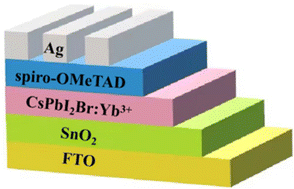Lanthanide ion doping enabling highly sensitive and stable all-inorganic CsPbI2Br perovskite photodetectors†
Abstract
All-inorganic perovskites have been widely explored for high-performance photodetectors (PDs), owing to their high carrier mobility, long carrier diffusion length, and excellent visible light absorption, etc. However, the poor film quality of solution-prepared all-inorganic perovskites inevitably limits the development of PDs. Here, we present the successful incorporation of lanthanide ions (Ln3+ = Pr3+, Gd3+, Nd3+, Eu3+, Tm3+, Ho3+, and Yb3+) into all-inorganic CsPbI2Br films to significantly improve the film quality and largely enhance the performance of PDs. Arising from the enlarged grain size and enhanced crystallinity of perovskite films upon Ln3+ doping, the detectivity (D*) and stability of PDs are significantly improved. In particular, PDs with Yb3+ doping achieve the best performance, and display an effective response range of 300–700 nm and quick response time (640 ns) with a D* of 4.6 × 1012 Jones in contrast to 3.7 × 109 Jones for pristine PDs. These findings offer new insights into the development of high quality perovskite films and highly sensitive and stable PDs.

- This article is part of the themed collection: 2023 Journal of Materials Chemistry C HOT Papers


 Please wait while we load your content...
Please wait while we load your content...